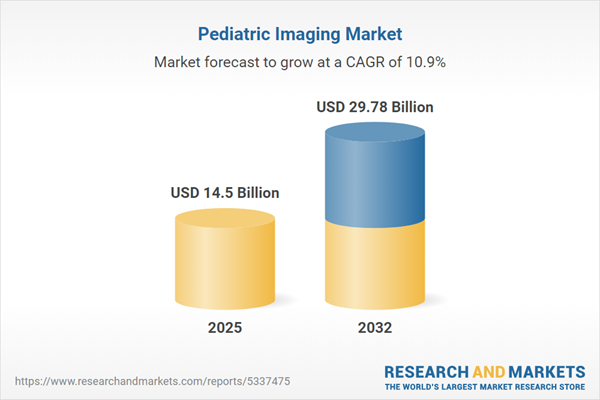Speak directly to the analyst to clarify any post sales queries you may have.
The pediatric imaging market is evolving rapidly, driven by breakthroughs in diagnostic modalities, stricter safety protocols, and advancements in digital technologies. Providers and industry leaders require clear insight into both technological and regulatory drivers shaping this landscape to make informed strategic decisions that advance clinical and operational goals.
Market Snapshot: Pediatric Imaging Market Size and Growth
The pediatric imaging market grew from USD 13.05 billion in 2024 to USD 14.50 billion in 2025, and is projected to continue expanding at a compound annual growth rate (CAGR) of 10.86%, ultimately reaching USD 29.78 billion by 2032. This growth reflects substantial investment in next-generation equipment, expanded diagnostic capabilities, and heightened focus on patient-centric care models within childhood healthcare settings.
Scope & Segmentation
- Modality
- Computed Tomography
- Magnetic Resonance Imaging
- Nuclear Imaging (including Positron Emission Tomography and Single Photon Emission Computed Tomography)
- Ultrasound
- X-Ray
- Age Group
- Adolescent
- Child
- Infant
- Newborn
- Technology
- Computed Radiography
- Digital Radiography
- Film-Screen Radiography
- End User
- Clinics and Ambulatory Surgical Centers
- Diagnostic Centers
- Hospitals
- Research Institutes
- Application
- Cardiology
- General Imaging
- Neurology
- Oncology
- Orthopedics
- Region
- Americas (United States, Canada, Mexico, Brazil, Argentina, Chile, Colombia, Peru)
- Europe, Middle East & Africa (United Kingdom, Germany, France, Russia, Italy, Spain, Netherlands, Sweden, Poland, Switzerland, United Arab Emirates, Saudi Arabia, Qatar, Turkey, Israel, South Africa, Nigeria, Egypt, Kenya)
- Asia-Pacific (China, India, Japan, Australia, South Korea, Indonesia, Thailand, Malaysia, Singapore, Taiwan)
- Leading Companies
- Siemens Healthineers AG
- General Electric Company
- Canon Medical Systems Corporation
- Koninklijke Philips N.V.
- Fujifilm Holdings Corporation
- Shenzhen Mindray Bio-Medical Electronics Co., Ltd.
- Samsung Medison Co., Ltd.
- Agfa-Gevaert N.V.
- Shimadzu Corporation
- Konica Minolta, Inc.
Pediatric Imaging Market: Key Takeaways
- AI-enhanced diagnostic algorithms and cloud-based platforms are transforming interpretation, collaboration, and operational efficiency for providers.
- There is a notable shift toward hybrid and portable imaging modalities, supporting point-of-care diagnostics and reducing procedural invasiveness in pediatric settings.
- Stringent dose optimization protocols and evolving regulatory requirements have directly influenced capital allocation and clinical workflows.
- Competitive strategies include subscription-based equipment offerings, bundled software-maintenance agreements, and value-based contracting aimed at managing operational costs and increasing market differentiation.
- Regional incentives for local production are fostering supply chain diversification, with increasing investment in locally manufactured consumables and imaging accessories in emerging markets.
- Collaboration between manufacturers, academic institutions, and service providers accelerates the development and validation of pediatric-specific diagnostic protocols and novel contrast agents.
Tariff Impact: Cost Structure and Supply Chain Shifts
United States tariff adjustments scheduled for 2025 are expected to affect pediatric imaging equipment costs and sourcing strategies. Manufacturers and suppliers are considering alternative procurement and local manufacturing to address higher duties, which may temporarily influence equipment availability and lead to increased innovation in modular system design. Providers could face incremental cost pressures, prompting phased technology adoption and renegotiated service contracts to mitigate financial impacts.
Methodology & Data Sources
This report utilizes a multi-tiered research methodology, combining in-depth secondary review of journals, regulatory filings, and white papers with primary insights from structured interviews across industry stakeholders. Data were triangulated and validated for reliability, ensuring a holistic perspective on technology trends, policy changes, and market dynamics.
Why This Report Matters
- Identify actionable opportunities to optimize investment strategies and streamline pediatric clinical workflows.
- Clarify the operational and regulatory challenges posed by evolving policy, technology, and regional demand factors.
- Support decisions on capital direction, supply chain resilience, and strategic alliances in a shifting healthcare environment.
Conclusion
Senior decision-makers can leverage this comprehensive analysis to anticipate trends, manage operational risks, and build sustainable growth strategies in pediatric imaging. Informed choices today will drive improved diagnostic outcomes and organizational agility tomorrow.
Additional Product Information:
- Purchase of this report includes 1 year online access with quarterly updates.
- This report can be updated on request. Please contact our Customer Experience team using the Ask a Question widget on our website.
Table of Contents
3. Executive Summary
4. Market Overview
7. Cumulative Impact of Artificial Intelligence 2025
Companies Mentioned
The companies profiled in this Pediatric Imaging market report include:- Siemens Healthineers AG
- General Electric Company
- Canon Medical Systems Corporation
- Koninklijke Philips N.V.
- Fujifilm Holdings Corporation
- Shenzhen Mindray Bio-Medical Electronics Co., Ltd.
- Samsung Medison Co., Ltd.
- Agfa-Gevaert N.V.
- Shimadzu Corporation
- Konica Minolta, Inc.
Table Information
| Report Attribute | Details |
|---|---|
| No. of Pages | 193 |
| Published | October 2025 |
| Forecast Period | 2025 - 2032 |
| Estimated Market Value ( USD | $ 14.5 Billion |
| Forecasted Market Value ( USD | $ 29.78 Billion |
| Compound Annual Growth Rate | 10.8% |
| Regions Covered | Global |
| No. of Companies Mentioned | 11 |









